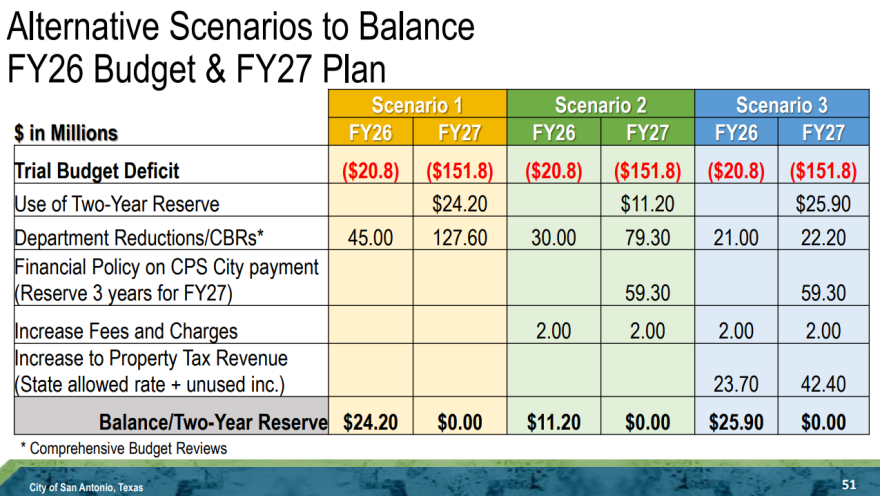Sign up for TPR Today, Texas Public Radio's newsletter that brings our top stories to your inbox each morning.
The new San Antonio City Council took its first official stab at how members plan to balance the city’s budget over the next two years, where the city currently projects a $21 million gap in Fiscal Year 2026 and a $152 million gap in Fiscal Year 2027.
Councilmembers outlined what they feel is most important to protect — or even expand — in next year’s budget, and while budget cuts of at least $20 million to city departments in each year are certain, few described what specifically should be on the chopping block.
One of the few things that they appeared unanimous on was that an increase in property taxes was unacceptable.
City Manager Erik Walsh presented three scenarios for how the city can balance the budget in the next two years, and he made clear that they were broad frameworks rather than the only three routes to solve the city’s budget gaps.
“These are three of many scenarios, but they're designed to lay out a spectrum,” Walsh said.
Scenario 1 would balance the budget based almost entirely on cuts to city departments — $45 million in FY 26 and $128 million in FY 27 — and by using $24 million of the city’s budget reserve.

Scenario 2 would cut $30 million from city departments in FY 26 and $79 million from city departments in FY 27, generate $2 million more in resident fees and charges in both fiscal years, use nearly $60 million in CPS Energy surplus revenues in FY 27, and draw on $11 million from the city’s reserve.
Scenario 3 would increase property taxes to generate $23.7 million in FY 26 and $42.4 million in FY 27, cut $21 million and $22 million from city departments in each year, hold onto nearly $60 million in CPS Energy surplus revenues, generate $2 million more in resident fees and charges, and use $26 million from the city’s reserve.
The council has had a policy for the last year that CPS Energy revenue surpluses for its off-system energy sales above $10 million would go back to the energy utility to mitigate rate hikes, though some council members have had second thoughts about its usefulness.
But the policy also makes clear that in situations where the city faces a budget deficit, it may take that surplus revenue and fill budget gaps with it, an idea that nearly half of the council at least expressed interest in considering further.
District 9 Councilmember Misty Spears and District 10 Councilmember Marc Whyte were the only two to endorse Scenario 1, which has the harshest cuts to city departments.
“It's time to focus on the must-haves and not the wants,” Whyte said.

However, both advocated for hiring dozens of new San Antonio Police Department officers, even though that would present an additional expense in the budget.
“I would like to see the 100 officers in year one, and 100 officers in year two, and I would like to see a focus on patrolling because we need to encourage crime prevention,” Spears said.
The city has a plan to hire 365 officers over a three-to-five-year span to increase the number of officers on patrol. One hundred and sixty-five officers have already been hired, and the city planned to hire 65 more next year, but that may be put on pause because of the budget shortage.
“If that means that if we stay on track over a three-to-five-year period, and we're at 50/50 for now … as long as we keep the council apprised of those outcomes, then those are the levers that they can pull later on,” Walsh said.
Councilmembers Sukh Kaur, Ric Galvan, and Ivalis Meza Gonzalez said they felt something closer to Scenario 2 would be their preference.
The city’s independent budget survey found the top five priority investment areas are services to assist the homeless, homeless encampment cleanups, streets, affordable housing, and Animal Care Services (ACS).
Council members generally agreed that streets, ACS, and the San Antonio Fire Department are services they cannot cut back on.
But while some suggested the city delay some infrastructure projects as a way to cut down costs, the only other somewhat specific suggestion was that homelessness encampment clearings be scaled back.
District 2 Councilmember Jalen McKee-Rodriguez said they were a waste of money because unhoused people will return as long as they don’t have somewhere better to go.

Most council members who endorsed either the deepest or more moderate level of department cuts did not specify which departments should be impacted, nor did council members who didn’t pick any of the proposed budget balancing scenarios.
Council members all agreed that the city’s core services — or “no-fail missions,” as Mayor Gina Ortiz Jones called them — need to be protected. But they did not agree on which services those were.
The city council and public won’t see specific potential department budget cuts until the proposed budget is presented to the council on Aug. 18.
The council’s budget work sessions and public town halls will begin in August.
The council will vote on the final budget on Sept. 18.



